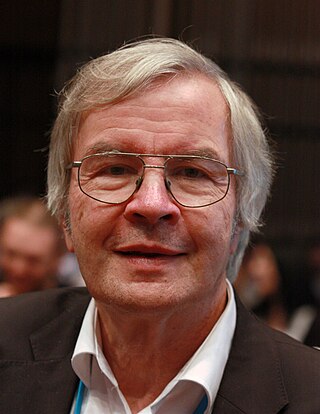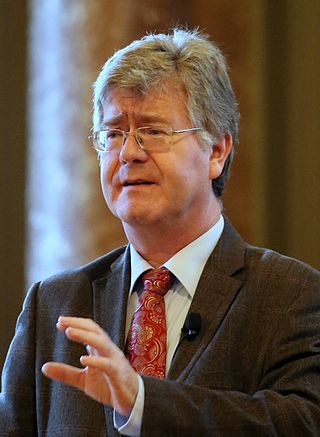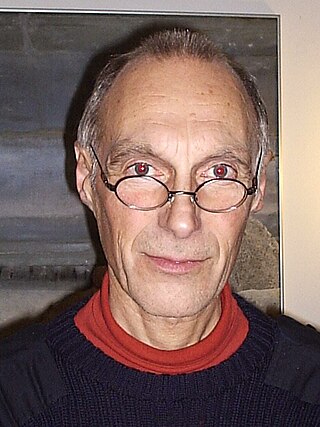
Wolfgang Haken was a German American mathematician who specialized in topology, in particular 3-manifolds.

William Daniel Phillips is an American physicist. He shared the Nobel Prize in Physics, in 1997, with Steven Chu and Claude Cohen-Tannoudji.
Paul Peter Ewald, FRS was a German crystallographer and physicist, a pioneer of X-ray diffraction methods.

The Max Planck Institute for Gravitational Physics is a Max Planck Institute whose research is aimed at investigating Einstein's theory of relativity and beyond: Mathematics, quantum gravity, astrophysical relativity, and gravitational-wave astronomy. The institute was founded in 1995 and is located in the Potsdam Science Park in Golm, Potsdam and in Hannover where it closely collaborates with the Leibniz University Hannover. Both the Potsdam and the Hannover parts of the institute are organized in three research departments and host a number of independent research groups.
Synergetics is an interdisciplinary science explaining the formation and self-organization of patterns and structures in open systems far from thermodynamic equilibrium. It is founded by Hermann Haken, inspired by the laser theory. Haken's interpretation of the laser principles as self-organization of non-equilibrium systems paved the way at the end of the 1960s to the development of synergetics. One of his successful popular books is Erfolgsgeheimnisse der Natur, translated into English as The Science of Structure: Synergetics.

Roy Jay Glauber was an American theoretical physicist. He was the Mallinckrodt Professor of Physics at Harvard University and Adjunct Professor of Optical Sciences at the University of Arizona. Born in New York City, he was awarded one half of the 2005 Nobel Prize in Physics "for his contribution to the quantum theory of optical coherence", with the other half shared by John L. Hall and Theodor W. Hänsch. In this work, published in 1963, he created a model for photodetection and explained the fundamental characteristics of different types of light, such as laser light and light from light bulbs. His theories are widely used in the field of quantum optics. In statistical physics he pioneered the study of the dynamics of first-order phase transitions, since he first defined and investigated the stochastic dynamics of an Ising model in a paper published in 1963. He served on the National Advisory Board of the Center for Arms Control and Non-Proliferation, the research arms of Council for a Livable World.

Theodor Wolfgang Hänsch is a German physicist. He received one-third of the 2005 Nobel Prize in Physics for "contributions to the development of laser-based precision spectroscopy, including the optical frequency comb technique", sharing the prize with John L. Hall and Roy J. Glauber.

The Gottfried Wilhelm Leibniz Prize, or Leibniz Prize, is awarded by the German Research Foundation to "exceptional scientists and academics for their outstanding achievements in the field of research". Since 1986, up to ten prizes have been awarded annually to individuals or research groups working at a research institution in Germany or at a German research institution abroad. It is considered the most important research award in Germany.

Peter Zoller is a theoretical physicist from Austria. He is professor at the University of Innsbruck and works on quantum optics and quantum information and is best known for his pioneering research on quantum computing and quantum communication and for bridging quantum optics and solid state physics.

Giorgio Parisi is an Italian theoretical physicist, whose research has focused on quantum field theory, statistical mechanics and complex systems. His best known contributions are the QCD evolution equations for parton densities, obtained with Guido Altarelli, known as the Altarelli–Parisi or DGLAP equations, the exact solution of the Sherrington–Kirkpatrick model of spin glasses, the Kardar–Parisi–Zhang equation describing dynamic scaling of growing interfaces, and the study of whirling flocks of birds. He was awarded the 2021 Nobel Prize in Physics jointly with Klaus Hasselmann and Syukuro Manabe for groundbreaking contributions to theory of complex systems, in particular "for the discovery of the interplay of disorder and fluctuations in physical systems from atomic to planetary scales".

The Max Born Medal and Prize is a scientific prize awarded yearly by the German Physical Society (DPG) and the British Institute of Physics (IOP) in memory of the German physicist Max Born, who was a German-Jewish physicist, instrumental in the development of quantum mechanics. It was established in 1972, and first awarded in 1973.

The Max-Planck-Institute of Quantum Optics is a part of the Max Planck Society which operates 87 research facilities in Germany.
Herbert Walther was a leader in the fields of quantum optics and laser physics. He was a founding director of the Max Planck Institute of Quantum Optics (MPQ) in Garching, Germany. He also was Chair of Physics at Ludwig Maximilian University of Munich. He is primarily known for his experimental work on cavity quantum electrodynamics as well his groundbreaking work on the ion trap.
Girish S. Agarwal, Fellow of the Royal Society UK, is a theoretical physicist. He is currently at the Texas A & M University with affiliations to the Departments of Biological and Agricultural Engineering, Physics and Astronomy, and the Institute for Quantum Science and Engineering. Earlier he worked as Noble Foundation Chair and the Regents Professor at the Oklahoma State University. He is a recognized leader in the field of quantum optics and also has made major contributions to the fields of nonlinear optics, nanophotonics and plasmonics. In 2013 he published the textbook "Quantum Optics", covering a wide range of recent developments in the field, which has been well received by the community.
Harry Jeffrey Kimble, was the William L. Valentine Professor and professor of physics at Caltech. His research is in quantum optics and is noted for groundbreaking experiments in physics including one of the first demonstrations of teleportation of a quantum state, quantum logic gate, and the development of the first single atom laser. According to Elizabeth Rogan, OSA CEO, "Jeff has led a revolution in modern physics through his pioneering research in the coherent control of the interactions of light and matter." Kimble's main research focus is in quantum information science and the quantum dynamics of open systems.
Robert Graham is a German theoretical physicist.

Wolfgang P. Schleich is professor of theoretical physics and director of the quantum physics department at the University of Ulm.

Werner Nahm is a German theoretical physicist. He has made contributions to mathematical physics and fundamental theoretical physics.

Siegfried Grossmann is a German theoretical physicist who has been awarded the Max Planck Medal, the major prize for achievements in theoretical physics.

Hans J. van Ommeren Dekker is a Dutch theoretical physicist in the line of Dirk Polder, Ralph Kronig, and Nico van Kampen. His scientific work inter alia involves laser theory, path integrals in curved spaces, nonequilibrium statistical mechanics, dissipation in quantum mechanics, and hydrodynamic turbulence. He is director of the Private Institute for Advanced Study and professor emeritus at the Institute for Theoretical Physics of the University of Amsterdam.














